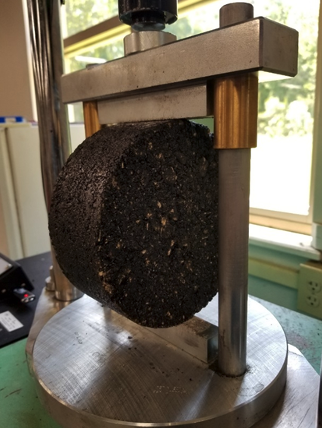- 2023 Fall
NCAT submits Draft Test Method for HT-IDT to ASTM

The high-temperature indirect tension test (HT-IDT) is gaining interest as a BMD test for rutting susceptibility.
The HT-IDT was first suggested as a rutting indicator for mix design by Christensen et al. in National Cooperative Highway Research Program (NCHRP) Report 673 in 2011. Their original work involved specimens compacted to Ndesign.
Other researchers have since demonstrated a good correlation between the HT-IDT and more popular rutting tests, like the Asphalt Pavement Analyzer (Bennert, et al. 2018) and the Hamburg Wheel Tracking Test (HWTT) (Chen, et al. 2023).
Recognizing the potential for widespread adoption of this test and the need for a national standard test method, NCAT researchers submitted a draft test method for the HT-IDT to the American Society for Testing and Materials (ASTM), which develops and publishes voluntary consensus technical standards.
The current ASTM method for the indirect tension test (ASTM D6931) is typically used for intermediate-temperature testing to assess the potential for cracking or moisture damage.
A few states are evaluating the HT-IDT as a simple rutting test for BMD. However, without a national standard, the test methods being used by the states are slightly different, which could cause confusion about results and proposed criteria.
Before widespread adoption, test parameters like test temperature selection, specimen thickness and air void content, conditioning method and time, etc. must first be standardized.
In 2021, NCAT conducted a study to compare results from rapid rutting tests (including the HT-IDT) with the results of wheel tracking tests. That study, summarized in the Spring 2023 edition of Asphalt Technology News, found the HT-IDT results were strongly correlated with Hamburg Wheel-Tracking Test (HWTT) results for the surface mixtures placed on the 2021 NCAT Test Track.
Based on the relationship between the HT-IDT and HWTT results, NCAT researchers suggested 20 psi as a reasonable threshold value for rutting with the HT-IDT test at the NCAT Test Track. This criterion will be further evaluated when the final field rutting data from the 2021 Track are available.
The ASTM draft test method includes information from the 2021 NCAT Round Robin for a preliminary precision and bias statement. Sixteen labs participated in the HT-IDT round-robin from which it was determined that the within-lab coefficient of variation (CV) was 8.3% and the between-lab CV was 14.6% for the single mixture used in that study.
The draft test method for a national standard for the HT-IDT was balloted by ASTM in August and September of 2023. It is anticipated that the asphalt testing stakeholders will provide feedback in the form of comments or negative votes until a standardized test is approved.
Establishing a national standard for the HT-IDT will continue to elevate the utility of performance tests being considered for BMD. Stakeholders that are not currently using the HT-IDT would be able to adopt or modify the national standard to suit their needs and decrease the potential for rutting in pavements.
References
Advanced Asphalt Technologies, LLC. 2011. NCHRP Report 673: A Manual for Design of Hot Mix Asphalt with Commentary. Transportation Research Board, Washington, DC.
Bennert, T, E. Haas, and E. Wass (2018) Indirect Tensile Test (IDT) to Determine Asphalt Mixture Performance Indicators during Quality Control Testing in New Jersey, Transportation Research Record 2018, Vol. 2672(28). National Academies of Sciences.
Chen et al (2023) Validation of Rapid Rutting Test Procedures Using Plant Mixtures from the 2021 NCAT Test Track, Asphalt Technology News, Spring 2023 Edition.


Contact Nathan Moore at nathan.moore@auburn.edu or Adam Taylor at tayloa3@auburn.edu for more information about this project.